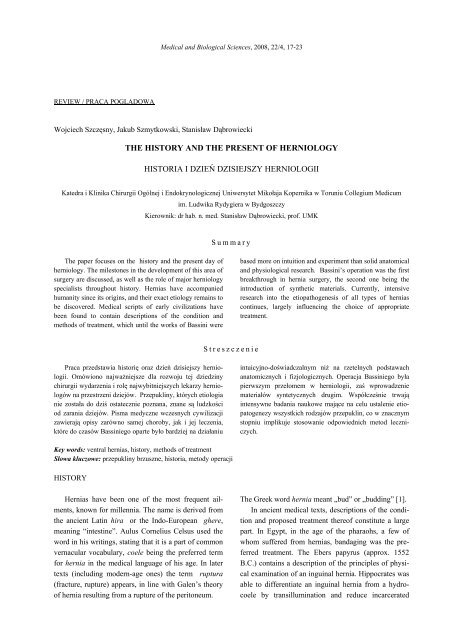medical and biological sciences - Collegium Medicum - Uniwersytet ...
medical and biological sciences - Collegium Medicum - Uniwersytet ...
medical and biological sciences - Collegium Medicum - Uniwersytet ...
You also want an ePaper? Increase the reach of your titles
YUMPU automatically turns print PDFs into web optimized ePapers that Google loves.
Medical <strong>and</strong> Biological Sciences, 2008, 22/4, 17-23REVIEW / PRACA POGLĄDOWAWojciech Szczęsny, Jakub Szmytkowski, Stanisław DąbrowieckiTHE HISTORY AND THE PRESENT OF HERNIOLOGYHISTORIA I DZIEŃ DZISIEJSZY HERNIOLOGIIKatedra i Klinika Chirurgii Ogólnej i Endokrynologicznej <strong>Uniwersytet</strong> Mikołaja Kopernika w Toruniu <strong>Collegium</strong> <strong>Medicum</strong>im. Ludwika Rydygiera w BydgoszczyKierownik: dr hab. n. med. Stanisław Dąbrowiecki, prof. UMKSummaryThe paper focuses on the history <strong>and</strong> the present day ofherniology. The milestones in the development of this area ofsurgery are discussed, as well as the role of major herniologyspecialists throughout history. Hernias have accompaniedhumanity since its origins, <strong>and</strong> their exact etiology remains tobe discovered. Medical scripts of early civilizations havebeen found to contain descriptions of the condition <strong>and</strong>methods of treatment, which until the works of Bassini werebased more on intuition <strong>and</strong> experiment than solid anatomical<strong>and</strong> physiological research. Bassini’s operation was the firstbreakthrough in hernia surgery, the second one being theintroduction of synthetic materials. Currently, intensiveresearch into the etiopathogenesis of all types of herniascontinues, largely influencing the choice of appropriatetreatment.StreszczeniePraca przedstawia historię oraz dzień dzisiejszy herniologii.Omówiono najważniejsze dla rozwoju tej dziedzinychirurgii wydarzenia i rolę najwybitniejszych lekarzy herniologówna przestrzeni dziejów. Przepukliny, których etiologianie została do dziś ostatecznie poznana, znane są ludzkościod zarania dziejów. Pisma medyczne wczesnych cywilizacjizawierają opisy zarówno samej choroby, jak i jej leczenia,które do czasów Bassiniego oparte było bardziej na działaniuintuicyjno-doświadczalnym niż na rzetelnych podstawachanatomicznych i fizjologicznych. Operacja Bassiniego byłapierwszym przełomem w herniologii, zaś wprowadzeniemateriałów syntetycznych drugim. Współcześnie trwająintensywne badania naukowe mające na celu ustalenie etiopatogenezywszystkich rodzajów przepuklin, co w znacznymstopniu implikuje stosowanie odpowiednich metod leczniczych.Key words: ventral hernias, history, methods of treatmentSłowa kluczowe: przepukliny brzuszne, historia, metody operacjiHISTORYHernias have been one of the most frequent ailments,known for millennia. The name is derived fromthe ancient Latin hira or the Indo-European ghere,meaning “intestine”. Aulus Cornelius Celsus used theword in his writings, stating that it is a part of commonvernacular vocabulary, coele being the preferred termfor hernia in the <strong>medical</strong> language of his age. In latertexts (including modern-age ones) the term ruptura(fracture, rupture) appears, in line with Galen’s theoryof hernia resulting from a rupture of the peritoneum.The Greek word hernia meant „bud” or „budding” [1].In ancient <strong>medical</strong> texts, descriptions of the condition<strong>and</strong> proposed treatment thereof constitute a largepart. In Egypt, in the age of the pharaohs, a few ofwhom suffered from hernias, b<strong>and</strong>aging was the preferredtreatment. The Ebers papyrus (approx. 1552B.C.) contains a description of the principles of physicalexamination of an inguinal hernia. Hippocrates wasable to differentiate an inguinal hernia from a hydrocoeleby transillumination <strong>and</strong> reduce incarcerated
















